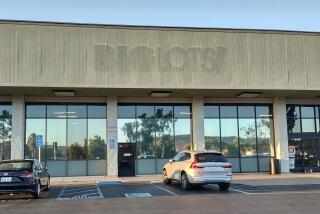‘86 Merger Mania Changed the Face of State’s Retailers
- Share via
Vons, Zodys, Thrifty, Gemco, Safeway, Boys Market, Stater Bros., May Co., J. W. Robinson, Carter Hawley Hale, Lucky--and Vons again.
It’s fitting that Vons Grocery of El Monte bracket this roster of California retailers, all of which participated in the wave of mergers, takeover efforts, leveraged buyouts and restructurings that swept their industry in 1986.
After all, the food retailer single-handedly demonstrated a penchant for dramatic action--converting to private ownership last January, then announcing plans in the final hours of Dec. 31 to go public again through a complex merger.
From supermarkets to drugstores to discount stores to department stores, the year just past was one of upheaval in California that saw the demise of well-known chains, forced many changes in ownership and, in a few cases, resulted in the creation of new companies.
May Co. and Robinson’s became siblings under the same parent company, while the Broadway’s parent made plans to divide up its family of stores into two pieces--department stores and specialty stores. Meanwhile, such names as Ohrbach’s, Gemco and Zodys disappeared.
In 1986, it was retailing’s turn to experience the merger and acquisition mania that had already torn through such industries as energy, transportation and consumer products.
Once takeover artists belatedly realized that the merchants’ undervalued stocks sheltered rich real estate interests and valuable franchises, few retailers were safe from their attentions.
“It’s part of the larger scene of what’s going on in corporate America,” said Philip M. Hawley, chairman and chief executive of Carter Hawley Hale Stores, the Los Angeles-based parent of the Broadway and Neiman-Marcus, which in December announced a restructuring that thwarted an unwanted takeover bid.
“You saw this going on very heavily in the energy industry over the past several years. You’ve now seen it working its way through in retailing.”
In many cases, the deals had or will have profound effects on the financial and management structures of California-based retailing institutions, although customers may not notice many changes--at least in the near future. If anything, merchandising and strategies at the affected stores are likely to evolve as new owners respond to the fierce competition among retailers in Southern California.
Hawley said that consumers can benefit from a company’s restructuring because retailers realize they “must be terribly sensitive to take good care of their customers.”
On the other hand, industry analyst Joseph H. Ellis said customers may also see some stores where they shop disappear, “with the real estate put to different uses.”
Even when the buyout or merger targets weren’t based in California, the deals ultimately touched stores where Californians shop. Consider two New York-based retailers: R. H. Macy & Co., with its well-known franchise in Northern California, which went private last summer in a $3.7-billion buyout, and Allied Stores, the parent of Bonwit Teller, Brooks Bros. and Ann Taylor, which knuckled under in November to Canadian real estate developer Campeau Corp.
When observers analyze why 1986 proved so fertile for all this corporate upheaval, they point to two elements that made retailers attractive: real estate and well-known chains.
“The first thing that comes to mind when you talk about the takeover activity in retailing is the real estate values,” said Peter K. Barker, a Los Angeles-based partner with the investment house of Goldman, Sachs & Co., which advised many retailers on both sides of the takeover game last year. “There was a view that some of these retailing companies could be broken up and the pieces sold for more than the whole.
“Indeed, you saw in the Allied Stores and Carter Hawley transactions the presence of knowledgeable real estate developers.”
Assets Liquidated
In many cases, companies liquidated their assets or borrowed against them to effect or prevent takeovers. For many participants, the rush was on to complete their deals before year-end to lock in more favorable tax provisions before they succumbed to the reform-minded legislation that kicked in Jan. 1.
Clearly, observers say, at the root of the activity was the stock market’s fascination with instant gratification. “The takeover game was the game to play, and everybody was getting into it,” said William N. Smith, a retail analyst with Smith Barney, Harris Upham in New York.
Frequently, however, the concerns of thousands of individual investors who held small stakes in these companies seemed to fade in importance as raiders and big investors battled over high stakes.
Small investors frequently complained that the real winners were the corporate raiders, who would take huge profits on stock-price run-ups, and investment bankers, with their multimillion-dollar fees.
And, while investment advisers and executives hammered out details of tender offers and restructurings, thousands of workers who lost jobs amid the turmoil slipped away with little notice on Wall Street.
The year began and ended with sizable layoffs. In February, 2,400 employees were let go at Zodys discount stores when HRT Industries closed the chain and sold or leased the locations.
In December, 14,000 Gemco workers fell victims to a restructuring by their parent company, Lucky Stores, which used proceeds from the sale of the money-losing unit to help thwart a takeover by New York investor Asher B. Edelman.
Some Left Market
(On a much smaller scale, other players announced plans to leave the California market. The Dutch-owned Ohrbach’s department stores and Golden Bear, an Ohio-based chain of consumer electronics stores, decided to leave California. And Allied Stores announced plans for its Bonwit Teller division to abandon its two locations in California this month and concentrate on growth in other regions.)
“Much of this merger and acquisition activity has done absolutely nothing to increase productivity,” said Richard Damm, a Sacramento consultant who advises a state commission looking into the effects of takeovers. “It’s not out there creating jobs. Clearly, if anything, it’s taking away jobs. Just ask any of the employees who used to work for Gemco.”
To be sure, the employment news wasn’t all bad. Ralphs Grocery of Compton, for example, converted 14 Zodys locations into a new warehouse-grocery concept, the Ralphs Giant. Most of the 80 Gemco locations were sold to the Target division of Dayton Hudson, which plans to open 54 discount stores on the sites.
Jonathan H. Ziegler, a supermarket analyst with Sutro & Co. in San Francisco, expects many laid-off workers to find new jobs. “Retailers have complained about inadequate labor, so people will find jobs but will have a new name on their paychecks,” he said.
The threat of massive layoffs is hanging over the 170,000 employees of Oakland-based Safeway Stores, which engineered a $4.1-billion buyout by the New York investment house of Kohlberg Kravis Roberts & Co. out of a gritty determination to avoid the clutches of a hostile suitor, Dart Group.
Many Lost Their Jobs
As of August, the United Food & Commercial Workers union said as many as 500 of Safeway’s 117,000 grocery cashiers, shelf stockers and other union workers had already lost their jobs, although the company said those were unrelated to the buyout.
Separately, the grocery chain eliminated about 300 positions, or 25% of the work force, at its corporate headquarters and a supply facility, calling the layoffs part of a “major restructuring of operations.”
In a leveraged buyout, a company is bought with borrowed funds that are repaid with cash from company operations or from the sale of assets. Now, coping with the burden of its high debt, Safeway has said it plans to seek concessions from workers in some parts of the country or close operations.
“We have said we have debt to service and will sell some unspecified assets,” said spokeswoman Felicia del Campo. To the relief of many California workers, the company said in a letter in November that it intends to retain divisions in Northern and Southern California, Seattle, Portland, Ore., Phoenix, Washington, D.C., and Canada.
In some cases, the takeover target goes willingly. Thrifty, a well-known Los Angeles-based California drug chain, gladly entered the fold of a new parent company, Pacific Lighting--another Southern California institution and owner of Southern California Gas--in a lucrative deal that removed Thrifty’s finances from the public spotlight.
Then there was May Department Stores, which only after weeks of effort succeeded in taking over Associated Dry Goods, the parent of Robinson’s.
Firmer Cost Controls
Here’s one case where customers are likely to notice some changes. Soon after the deal was completed, May made it clear to the investment community that it intended to shave losses at Robinson’s by maintaining firmer control over costs.
Although corporate officials at May Departments Stores in St. Louis flatly deny it, industry observers say that they’ve heard that May executives have told Robinson’s to focus on more moderate lines and to become more promotion-minded.
At the same time, the company a few months ago began using the initials “JW” in front of Robinson’s (for founder Joseph Winchester Robinson) on stores and in advertising in what observers said appeared to be an effort to achieve a more traditional, upscale aura.
At Carter Hawley Hale Stores, on the other hand, a massive restructuring fended off an unwanted suitor--the Limited--which had come around unbidden for the second time in 2 1/2 years, this time with the aid of Ohio developer Edward J. DeBartolo Sr.
(Interestingly, in 1984, Carter Hawley had become the first of the traditional, publicly listed retailing companies to go through an anti-takeover battle.)
As far as Philip Hawley is concerned, well-known store franchises have been a key attraction to the takeover set. Why should a company go to the risky expense of starting a new concept when it can buy an old, established one?
“It’s very clear that the well-known names--Bullock’s or May Co. or Robinson’s or Broadway--have been built up over a great number of years,” he said. “While it’s possible for a new party to come in--Nordstrom demonstrated it can be done--it is extremely difficult and expensive to build stores at today’s costs, compared to the average cost of the existing network. It takes time to put an organization together, so those franchises are recognized as being valuable and hard to duplicate.”
Nordstrom, a Seattle-based company known for pampering its customers, has clearly demonstrated an ability to make inroads in new markets. With only 12 stores in Southern California, however, its effect has been more to set an industry standard for customer service than to steal significant market share.
Once all the dust has settled on the 1986 deals, will customers and companies emerge as winners or losers?
At Vons, management began the year by converting the company to private ownership in a highly leveraged buyout and ended it by announcing a merger with a Detroit supermarket company that, if completed, would instantly provide Vons with a public stock exchange listing, provide sizable profits for investors and enable Vons to restructure its debt.
“From the consumer’s standpoint, Vons is the same Vons it’s always been,” said Chairman Roger E. Stangeland. “In spite of all this activity behind the scenes, we’ve gone about our business.”
Even so, industry executives and observers say a takeover effort or restructuring inevitably steals valuable resources away from the business at hand, to the possible detriment of customers and companies. And, once the battle has been fought, the company then must cope with the consequences of its actions.
“We’re reducing our capital spending (and) focusing our capital spending on current markets and particularly current stores,” said John M. Lillie, chairman of Dublin, Calif.-based Lucky, which so far has successfully fended off investor Edelman with a massive restructuring. “We are reducing somewhat our new-store program, and that wouldn’t be healthy if it went on for very long.”
Ellis, an analyst with Goldman Sachs in New York, sees customers possibly suffering in two ways from the takeover activity.
“They may see acquired stores disappear, with the real estate put to different uses,” he said. “In cases where the companies were taken over by substantial debt loads, it probably indicates that future expansion will be reduced to some extent as companies strive to repay their debt.” But, he added, “it would only be an unwise management that would stop investing in existing stores.”
He does see at least one advantage. “In many cases, the companies acquired were retailers that had underperformed for one reason or another,” Ellis said. As a result, the takeover and restructuring process is “one of continuing elimination of the less able competitors and their replacement with companies that are stronger from the financial and merchandising standpoint.”
Must Perform Well
Philip Hawley contends that consumers can benefit. “It’s very clear when companies go through restructurings or buyouts that result in adding to the debt burden that those managements must be terribly sensitive to take good care of their customers,” he said. “They must perform well (to) service the debt.”
Macy’s, for example, which has the most experience as a highly leveraged, private retail company, is beefing up its customer service with an eye toward improving performance and, therefore, cash flow.
As for the companies, Hawley continued: “There’s no question that when a business like Macy’s or Safeway or Carter Hawley goes through a restructuring, it must take a very, very hard look at properties which are poor performers, and must be much less forgiving of marginal or sub-par performers.”
Campeau Corp., the new owner of Allied Stores, recently acknowledged that it plans to sell as many as 16 divisions to help pay off its debt. Interestingly, founder Robert Campeau of Toronto had said in September that he didn’t intend to sell Allied’s assets because both companies produced enough cash flow to absorb the interest costs.
On the supermarket side, analyst Ziegler of Sutro & Co. sees some benefits to the takeover and restructuring craze. “Ultimately, it’s a good thing,” he said. “Assets should become more efficient. In the short term, you have problems of debt, . . . but if you survive that period, you’ll probably end up in a more productive environment.”
However, Jack H. Brown, who weathered a battle for control of Stater Bros. and is now its chairman, sees a problem developing.
“Our industry has been successful because we’ve seen a merchandising need or have developed a new format and then have gone out and found a location that fit our format,” he said. “Today it appears as though some of the formats are being quickly put together because real estate opportunities have appeared.”
Ken Johnson, a member of Price Waterhouse’s Strategic Management Consulting Group and a supermarket specialist, does not anticipate much change for consumers as a result of the upheaval in the Southern California food business.
“It’s not really clear to me that the consumer benefits because overall price levels and service levels aren’t going to change that much,” he said. “They’re already about as good as they can be and have the competitors make any money.”
Debt Load Is Key
Companies that have heavier debt burdens stand to lose out, according to Barker, the Goldman Sachs partner. “To the extent that a retailer is in a strong position to increase market share because he does not have the debt burdens that a competitor does, he will use this period to try to make inroads into a weaker competitor,” he said. “Consequently, I would think that consumers will benefit from retailers trying to gain market share at the expense of weaker companies.”
For those who think that the upheaval in retailing has run its course, think again. “I wouldn’t rule out additional large acquisitions or restructurings in ‘87,” said David Jackson, a retailing analyst with Morgan, Olmstead, Kennedy & Gardner in Los Angeles. “Larger, slower-growing companies will augment their growth through acquisitions.”
He noted the decision announced last week by Sears, Roebuck & Co., the nation’s largest retailer, to look into acquisitions of specialty stores. “Sears has missed the boat by not being in specialty stores,” he said. “I think you’ll see them making some major acquisitions.”
More to Read
Inside the business of entertainment
The Wide Shot brings you news, analysis and insights on everything from streaming wars to production — and what it all means for the future.
You may occasionally receive promotional content from the Los Angeles Times.











